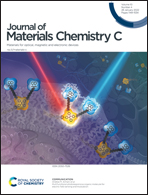Multifaceted, printable skin-integrated electronics for monitoring physiological functions†
Abstract
Printable skin-like power sources and self-powered electronic devices can be bio-integrated with the skin for broad applications in human healthcare and human–machine interfaces, among others. Nevertheless, most existing printed skin-like electronic devices have restricted functionality, unfavorable physiological effects, and restricted long-term feasibility, which constrain the mimicking of real human skin. Here, a simple and effective stencil sublimation printing (SSP) approach for fabricating a substrate-free energy harvesting-multifunctional-sensing system that can be directly printed onto the human skin with high breathability, high flexibility, conformability, on-skin adhesion, anti-inflammation, dry-degradability, and easy-washability is reported. Furthermore, the resulting system functions as an on-skin biofunctional power source and a multifunctional physiological sensing platform that can detect pressure, temperature, and hydration, providing an excellent skin-like electronic device with excellent mechanical durability. This work opens up a creative direction for integrating skin-like electronic devices with the human body, affording promising on-skin electronics with exceptional features and minimal invasiveness.



 Please wait while we load your content...
Please wait while we load your content...